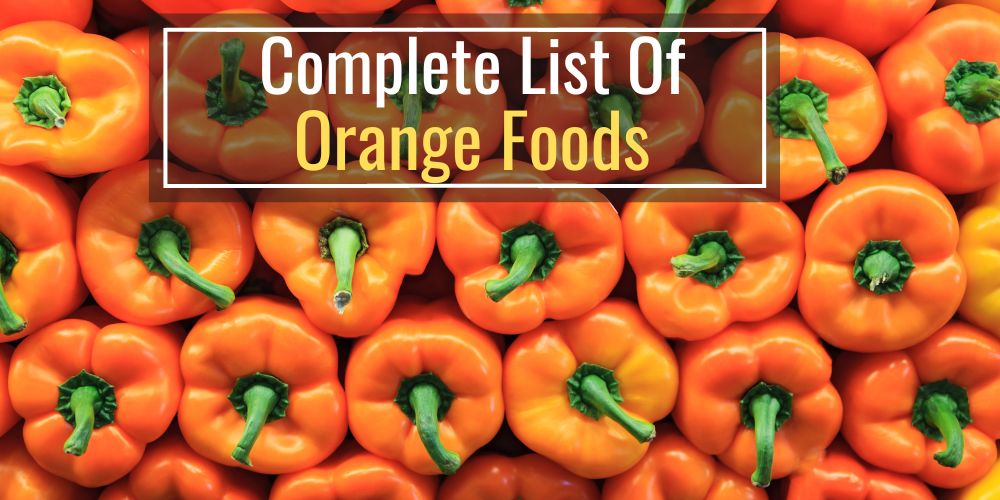Are you trying to think of orange foods but are having trouble getting past the obvious ones like oranges, cheese, or carrots?
Check out this comprehensive list of foods that are the color orange.
You will find something you love, from sweet and savory options to hearty meals.
So give these a try to start enjoying the benefits of orange foods today.
We’ve placed the list of orange foods below in alphabetical order so you can quickly skim through the list.
Here is a list of all the different food-colored lists with pictures if you’re looking for other colored foods:
1. Annatto
The first orange food on our list in Annatto.

Annatto is an orange or red fruit from the achiote tree, and it’s most popularly used as a food coloring or condiment in Latin American dishes.
It has a peppery taste, an earthy aftertaste, and a slightly sweet smell.
The color of the annatto can range from orange to deep red, depending on how it’s prepared.
Annatto is rich in Vitamin C, carotenes, and other antioxidants linked to health benefits like cancer prevention.
2. Apricot
Apricots are a type of stone fruit that comes from the Prunus armeniaca tree. This fruit is native to China that spread to Europe and other Western countries.
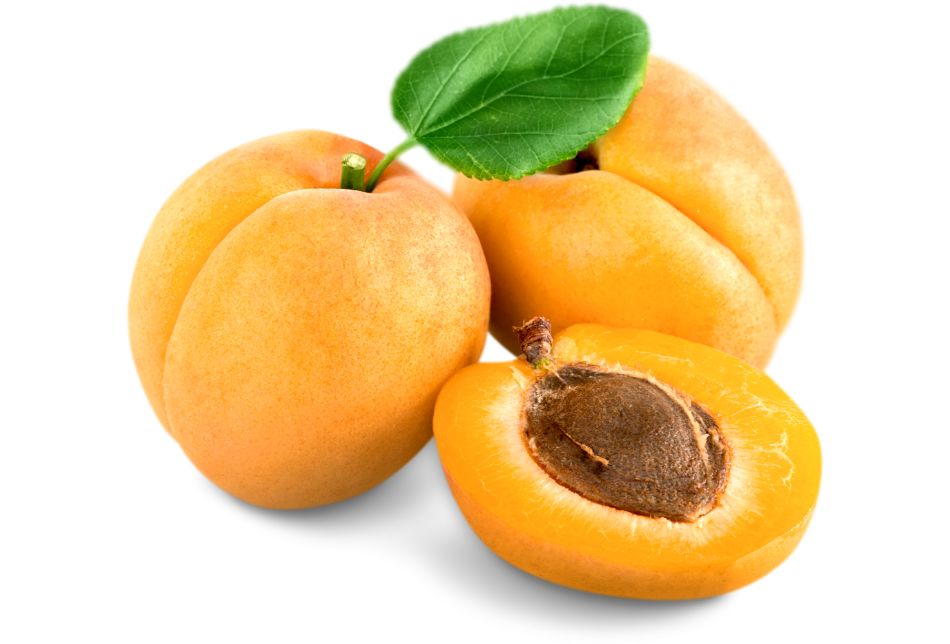
Apricots are small and round with a smooth, velvety exterior that can range in color from yellow to deep orange to orangish-red.
The flesh of the apricot is orange and soft, with a single large seed in the center.
Apricots are an excellent source of Vitamin A and contain smaller amounts of Vitamin C, E, and K. They’re often used as a natural remedy for constipation because of their high fiber content.
3. Butternut Squash
Butternut squash is a type of winter squash popular in the United States.
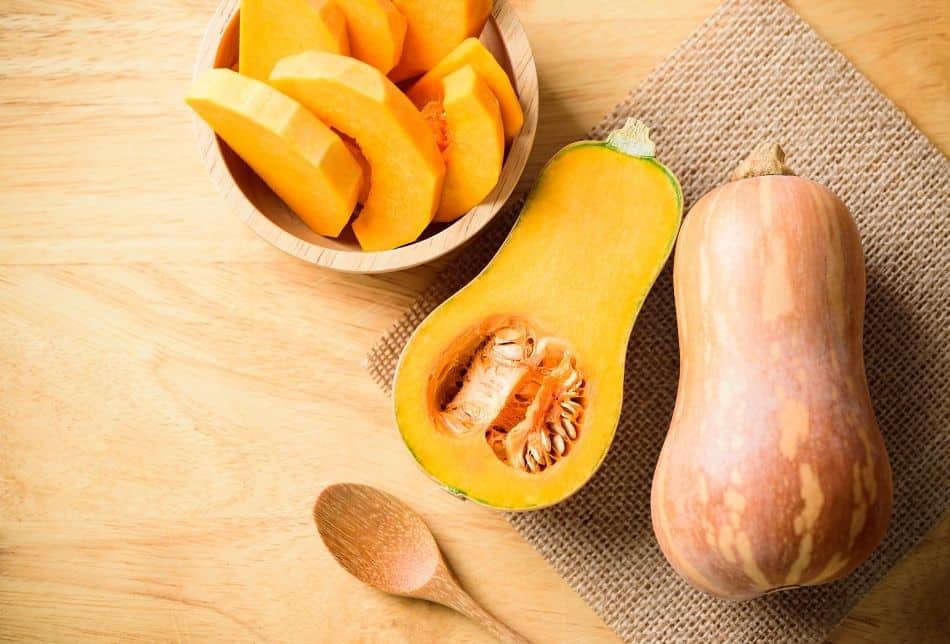
It has a pear-like shape and a light to dark orange color on the outside. The flesh is also orange and very dense. It has thick, hard skin and a sweet, nutty flavor.
Butternut squash is rich in vitamins A and C, fiber, and potassium. It can be roasted, pureed, or added to many recipes for a delicious and healthy treat.
Though not as thin or delicate as summer squash, the skin is edible, and you can even eat its seeds.
4. Calendula
Calendula is a type of flower that’s often used as a natural remedy or herbal tea.

The calendula flower petals can be eaten fresh, dried, or cooked.
The calendula flower is native to the Mediterranean countries. It has a slightly bitter taste with a vegetal hint. The color of the calendula ranges from yellow to orange.
Calendula is rich in flavonoids, carotenes, and other antioxidants.
5. Cantaloupe
Cantaloupe is a type of muskmelon, one of the world’s most popular fruits.
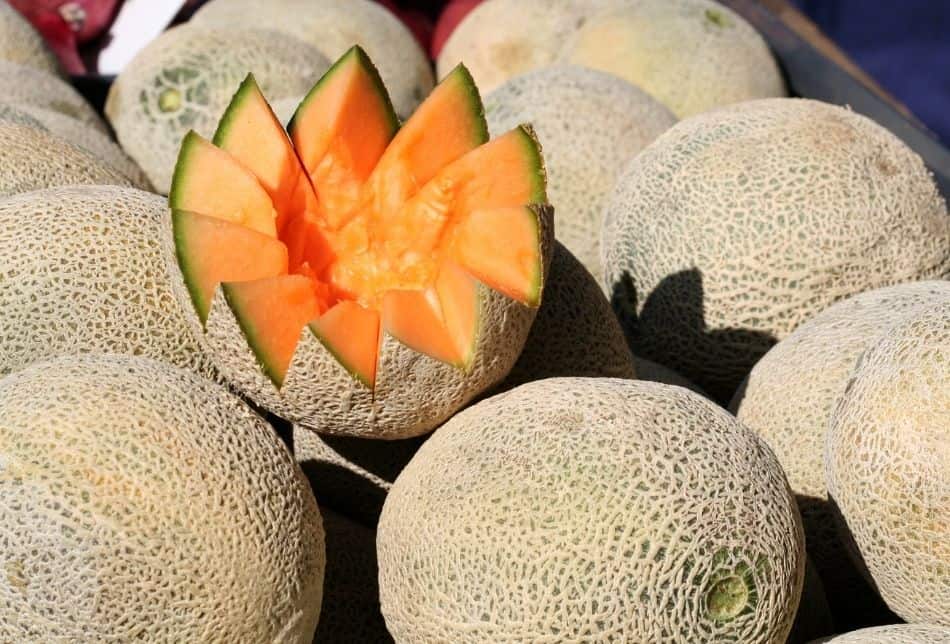
It has a light orange flesh with a sweet flavor and a slightly grainy texture (when over-ripe).
Cantaloupe is an excellent source of Vitamin C, potassium, and beta-carotene. Beta-carotene is converted to Vitamin A in the body, essential for vision, immunity, and cell growth.
Cantaloupes are thought to have originated in Egypt, and, most likely, they were first grown there or in India.
6. Cape Gooseberry
Cape gooseberry is a type of physalis, a fruit resembling a small, yellow cherry. It’s native to Peru, Ecuador, and Colombia.
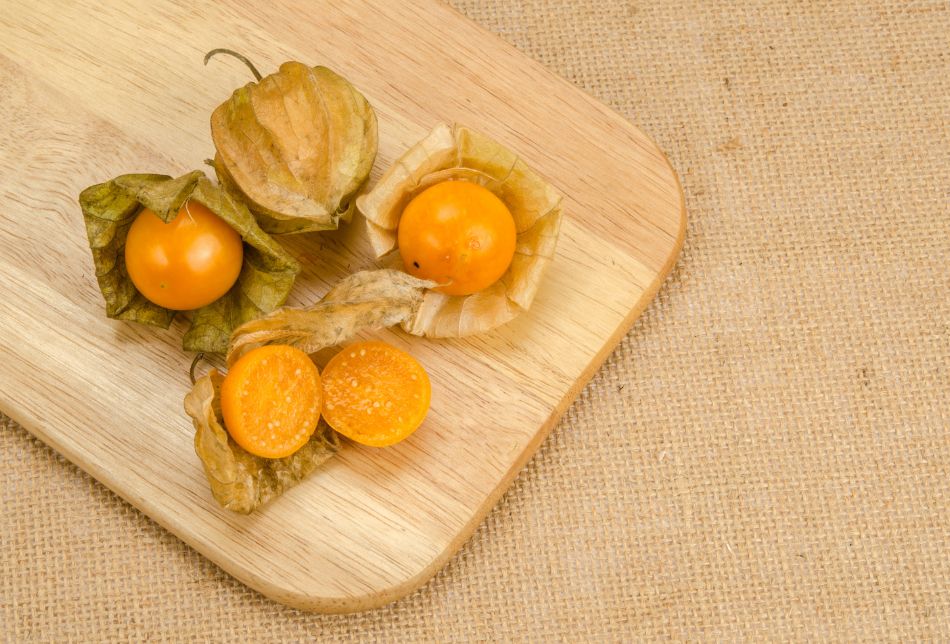
The cape gooseberry has a sweet-tart and tangy flavor with hints of pineapple, vanilla, strawberry, mango, and Meyer lemon.
It contains Vitamin C, carotenes, vitamins, and other phenolic substances.
Physalis fruits are often used in jams, pies, and other desserts.
They can also be eaten fresh or dried like raisins.
7. Chanterelle Mushrooms
Chanterelle mushrooms are a type of edible fungi that have an orange, yellow, and funnel-like shape. They grow in the wild and can also be cultivated.
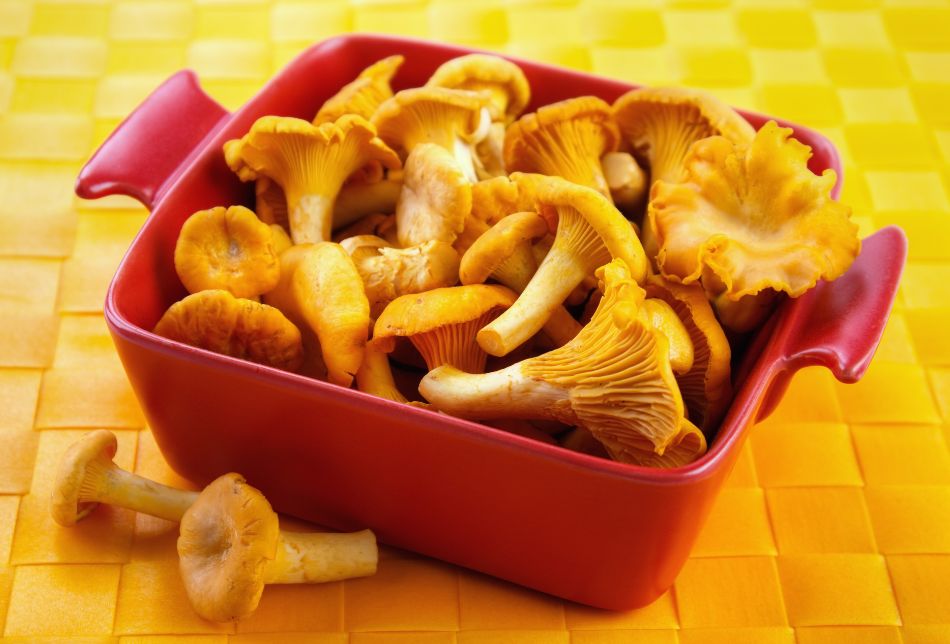
They have a fruity, slightly peppery flavor with hints of apricot or peach aroma.
Chanterelle mushrooms are a good source of vitamins B and D, as well as potassium and selenium.
Chanterelle mushrooms can be eaten fresh or cooked. They’re usually added to soups, sauces, omelets, and other dishes.
8. Cheddar Cheese
Cheddar cheese is a type of cow’s milk cheese that originated in England.
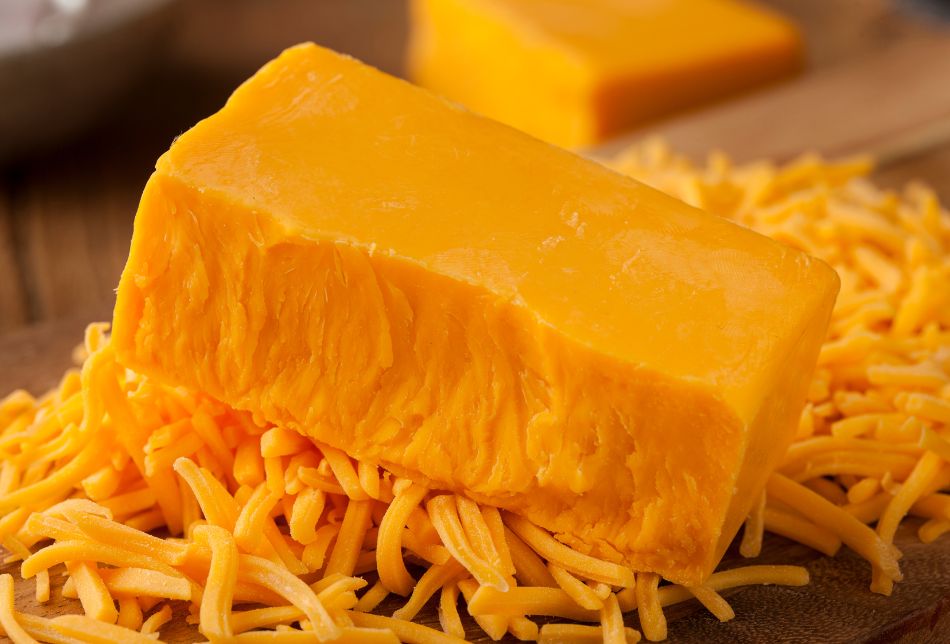
It’s now one of the most popular cheeses in the world.
Cheddar cheese has a sharp, tangy flavor with a nuts-like flavor that gets stronger with age. It’s also a good source of protein, calcium, and fat.
Cheddar cheese can be eaten on its own or used in cooking. One can find it in grilled cheese sandwiches, macaroni and cheese, and other dishes.
9. Cherry Tomatoes
Cherry tomatoes are small, round, and red (or yellow) in color, turning orange when ripe. They’re sweet with a slightly acidic flavor and are used in salads, sandwiches, and garnish.
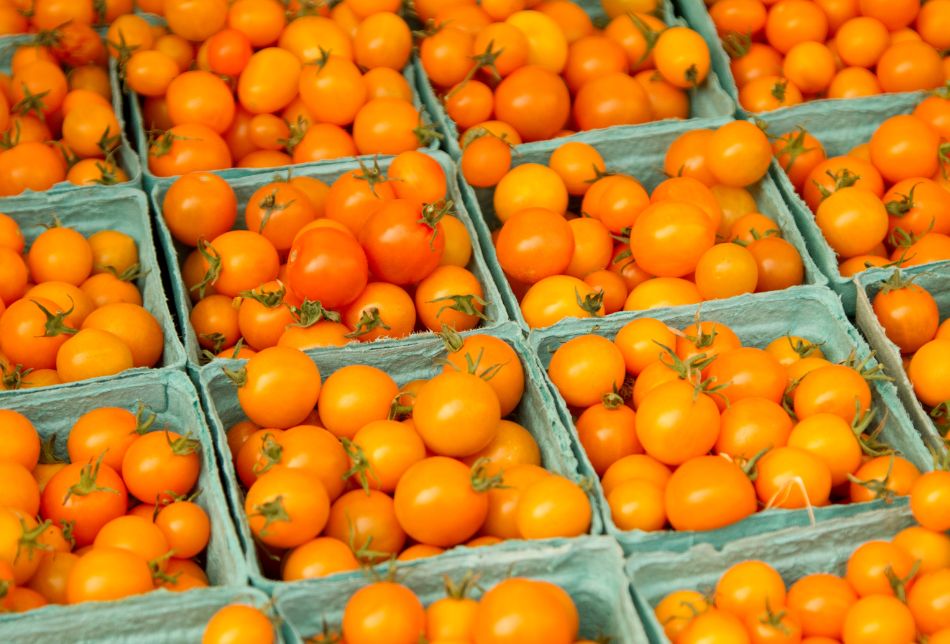
Cherry tomatoes originated in Equador 80,000 years back but are now grown worldwide. They consist of vitamins C and A and lycopene – an antioxidant linked to several health benefits.
While technically a fruit, cherry tomatoes are often used as vegetables in cooking.
10. Clementines
Clementines are a type of citrus fruit that’s similar to mandarins.
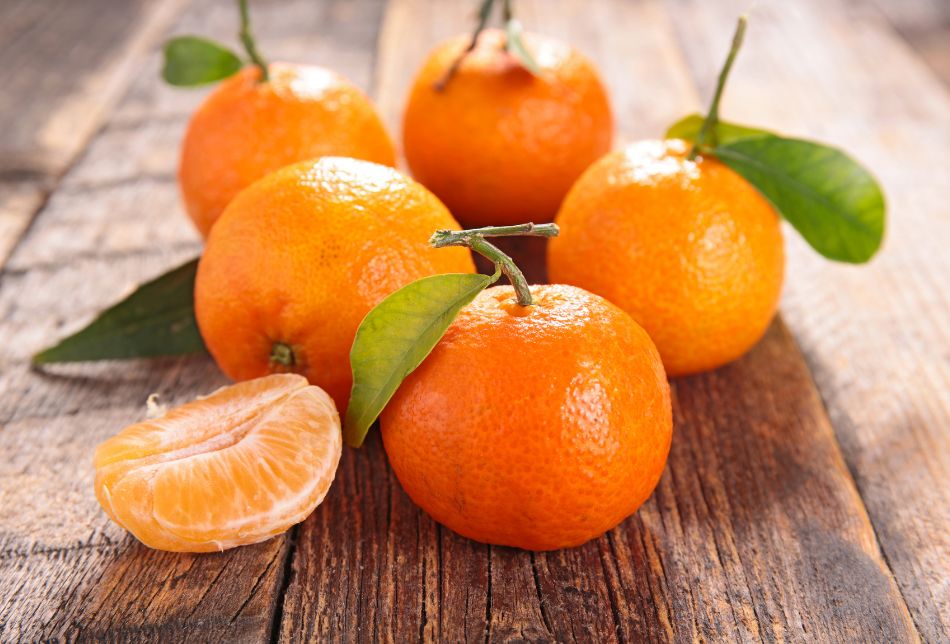
They’re small, round, and orange with smooth skin. Clementines are easy to peel and are seedless.
The flesh is juicy and sweet with a slightly tart flavor. Clementines are an excellent source of Vitamin C, potassium, and fiber.
They’re a cross between two other citrus fruits: a sweet orange (C. × sinensis) and a Mediterranean willow leaf mandarin orange (C. × deliciosa).
Clementines were first grown in the Canton region in China but are now cultivated worldwide.
11. Crab Roe
Crab roe is the orange-colored egg found inside a female crab. It is a delicacy in many cultures and has a slightly fishy taste.
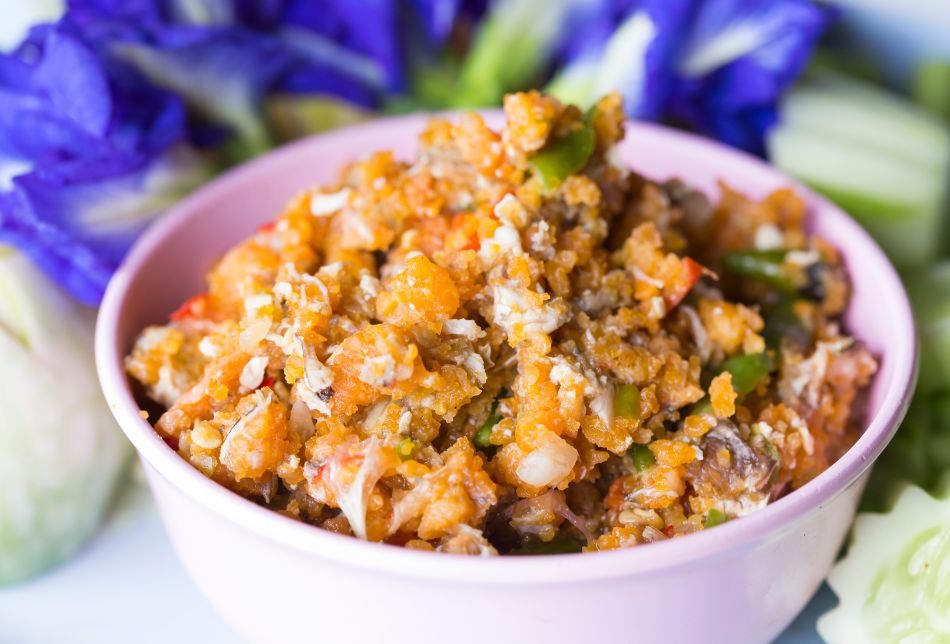
Crab roe is rich in omega-3 fatty acids, protein, and vitamins B12 and E. It also contains high levels of zinc, selenium, and copper.
Though it’s eaten as it is, crab roe can also be used in recipes like pasta dishes or omelets. It can also be pickled or canned.
12. Curry Powder
Curry powder is a spice blend used in Indian and Southeast Asia cuisine.
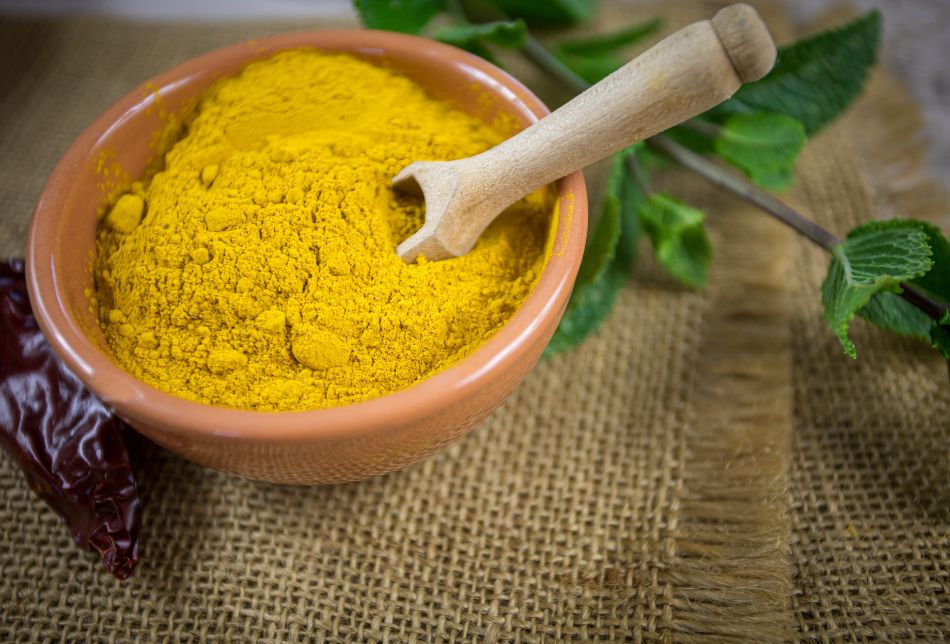
It contains cumin, coriander, turmeric, ginger, and chili peppers (among other spices).
The flavor of curry powder can vary depending on the ingredients and proportions used. Some curry powders are savory, while others are sweeter or spicier.
Curry powder adds flavor to chicken, fish, vegetables, and rice dishes. Some even use it as a dry rub for meat or can be added to soups and stews.
13. Dalandan
Dalandan is a type of citrus fruit that’s like an orange. It’s native to the Philippines but can now be found in other Southeast Asia countries.
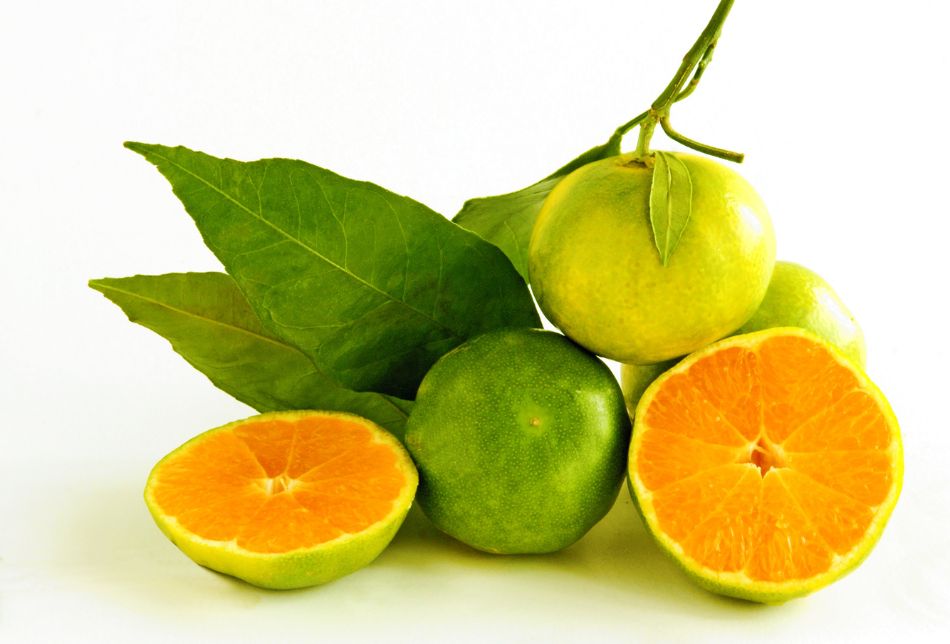
The skin of the dalandan is aromatic, thin, and easy to peel.
Although the skin color might be green, the orange flesh is juicy and acidic, with a sweet flavor that grows with maturation.
Dalandan is another source of Vitamin C, potassium, and fiber.
It adds a unique flavor to drinks or desserts. It, too, can be eaten fresh or added to salads for a pop of color and flavor.
A fact: The word “Dalandan” is a Tagalog term that came from the Spanish Naranja or orange.
14. Duck Sauce
Duck sauce is a type of condiment or sauce typically used in Chinese or American-Chinese cuisine. It’s made from fruits like apricots, plums, or peaches and has a sweet and sour flavor.
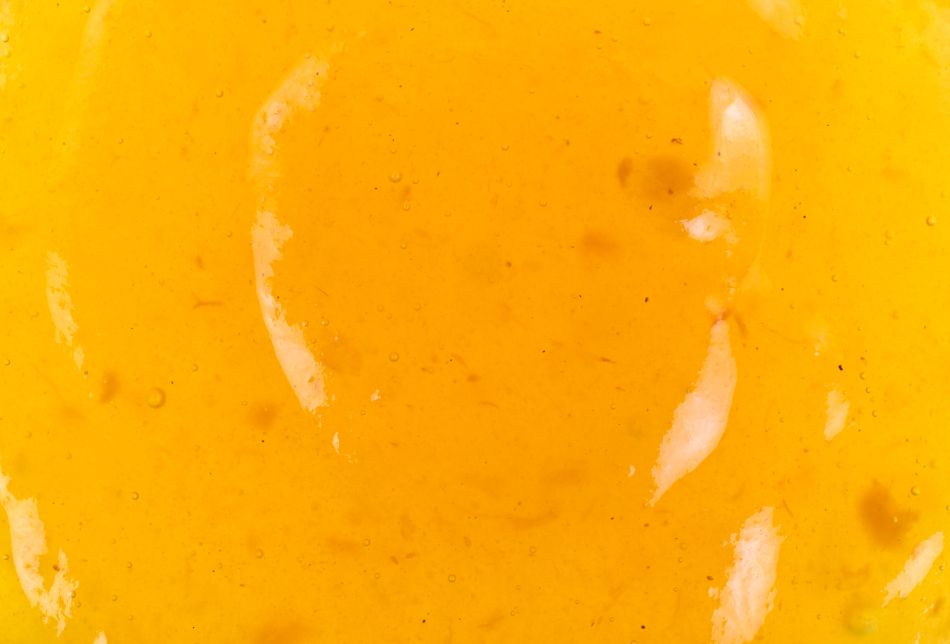
Duck sauce can also contain vinegar, spices, and other ingredients like red chili pepper or garlic.
It is eaten as a dipping sauce or used to flavor dishes like deep-fried fries.
This particular condiment is believed to have originated in China but gained popularity in the United States during the 20th century.
15. Dutch Mimolette
Mimolette is an orange-colored cheese that comes from Roucou in France.
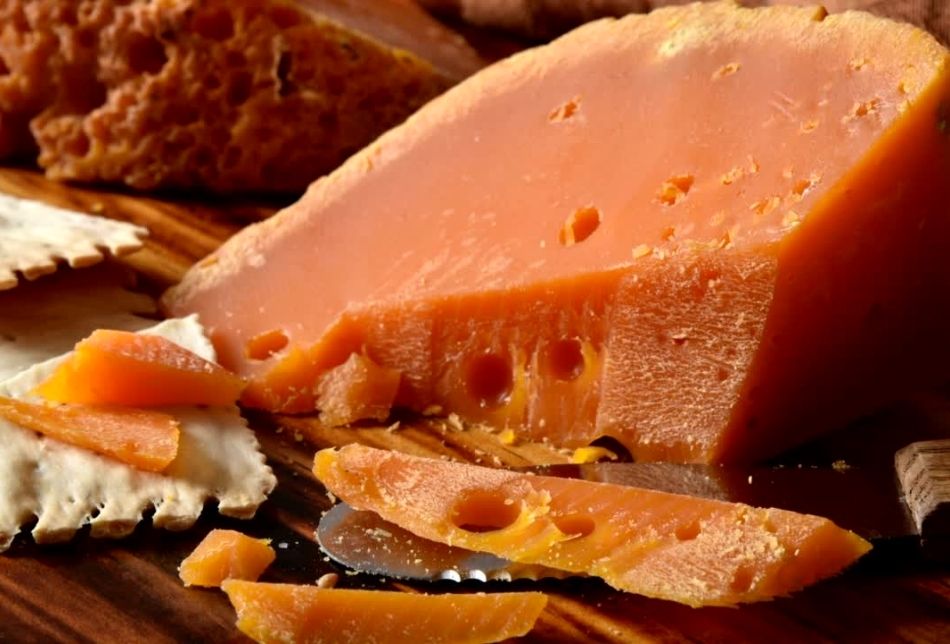
It has a natural rind and spherical shape, but sometimes it’s not as fresh because they need time to ripen after being made before eating or for making other things like torchons (a popular French dish).
Dutch Mimolette is suitable for recipes that call for grated or shredded cheese, such as an omelet, salad, or pasta. It is good for snacking too.
16. Gấc (Sweet Gourd)
Gấc is a type of fruit that’s native to Vietnam. It’s also grown in other parts of Southeast Asia, including Thailand, Cambodia, and Northeastern Australia.
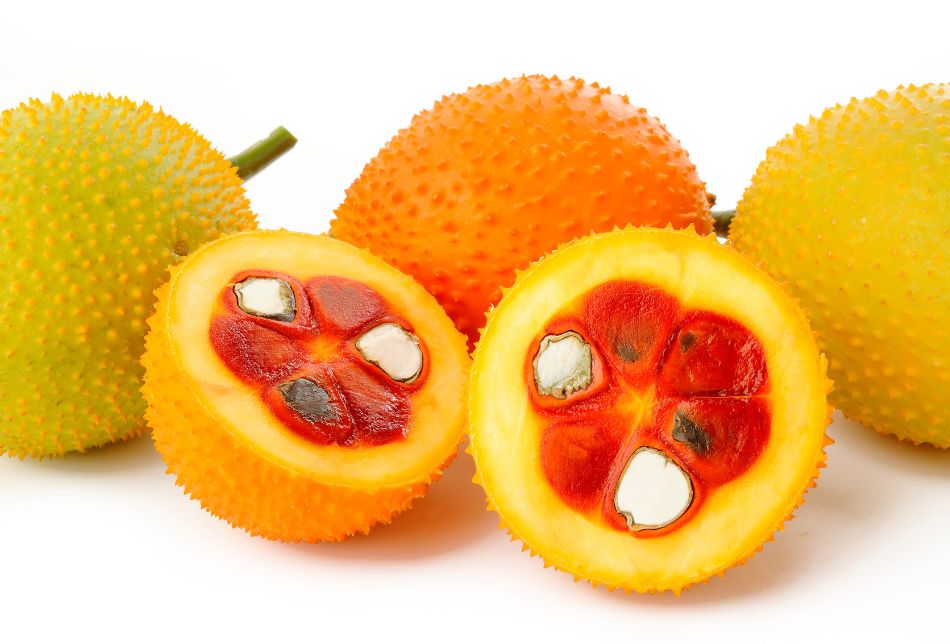
The fruit is oblong and has bright orangish-red skin with spikes and red flesh with a flavor similar to a tomato. It’s very sweet with a slightly thick texture.
Gấc is an excellent source of beta-carotene and lycopene.
Eat it fresh or use it in preserves, jams, and desserts. It can also be dried, ground to make a powder, and used as a decoration or added to herbal teas.
17. Grapefruit
Grapefruit is a type of citrus fruit similar to sweet oranges but larger in size and with a more bitter taste. The flesh can be pink, red, or white and is very juicy.
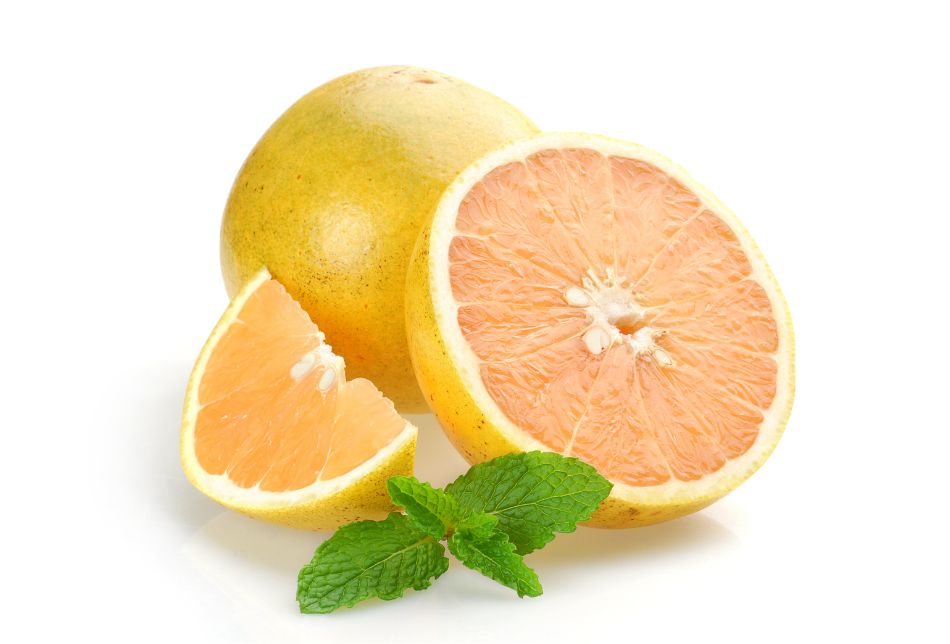
Similar to oranges, grapefruits have a bright orange skin.
Grapefruits are an ideal source of vitamin C, fiber, and antioxidants.
They can be eaten fresh or in juice. Some people also like to add grapefruit slices to their water for a refreshing and healthy drink.
The grapefruit was first cultivated in Barbados in the 18th century.
It’s a cross between the pomelo or shaddock and the sweet orange.
18. Horned Melon (Kiwano)
The horned melon is a cucurbit (belonging to the family Cucurbitaceae) native to Africa. It’s also African horned cucumber, jelly melon, melano, hedged gourd, or blowfish fruit.
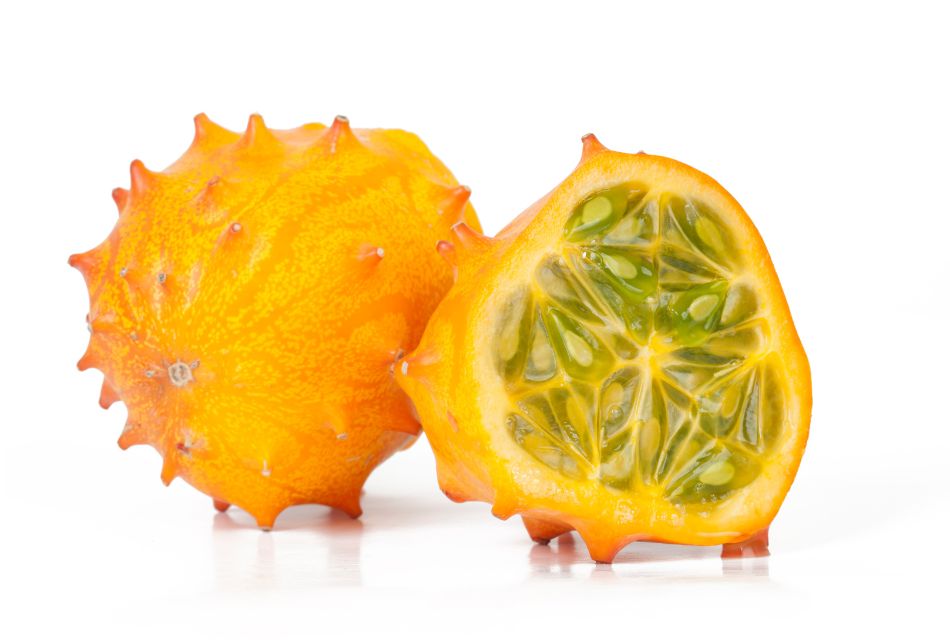
It has a bright orange exterior with orange or yellow horns (hence the name). The flesh is lime green or yellow and is gelatinous.
The seeds are edible, and the fruit tastes similar to cucumber seeds.
Horned melon is an excellent source of vitamins C, B6, copper, and potassium. It can be eaten raw or used in salads, smoothies, soups, and other dishes.
19. Kabocha Squash
Kabocha squash is a kind of winter squash that’s popular in Asia. It has a greenish-brown color on the outside with orange flesh on the inside.
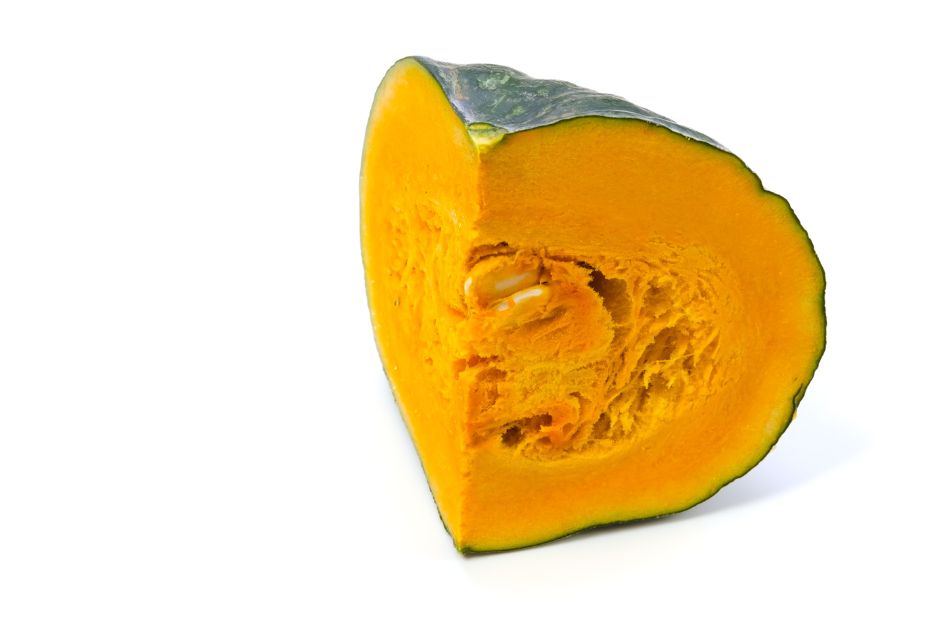
Kabocha squash has a sweet, nutty flavor and a dense, buttery texture.
It has an abundance of vitamins C and A, fiber, and potassium.
Kabocha squash can be roasted, pureed, or added to all sorts of recipes for a delicious and healthy treat.
It is often compared to sweet potatoes and water chestnuts because of its starchy, grainy flesh that has a consistency similar to these two vegetables.
20. Kumquats
Kumquats are a type of citrus fruit that’s native to Southern China.
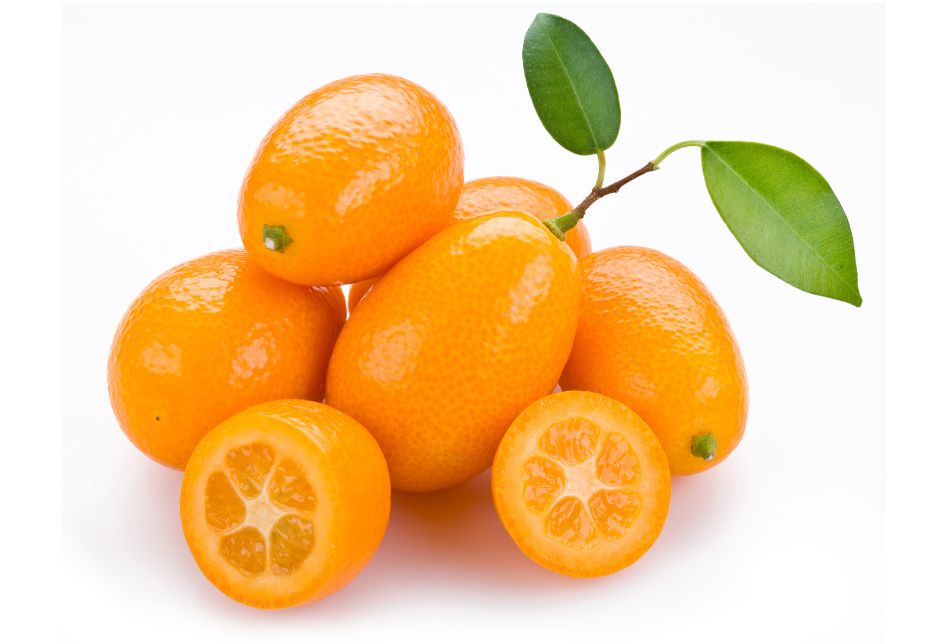
They’re small, oval-shaped fruits with a thin skin that’s orange on the outside and yellow on the inside. The flesh is also tart and slightly sweet.
Kumquats are an excellent source of Vitamin C, A, dietary fiber, and antioxidants.
They can be enjoyed fresh or used in all sorts of recipes, marmalades, and jellies, to name a few.
Fact: The word “kumquat” is derived from the Chinese term “golden orange,” which may have been applied because of its color.
21. Mamey Apple
The mamey apple is a tropical fruit that’s native to the Caribbean. It’s also called mammee apple, mammee, mamey apple, mamey, Santo Domingo apricot, South American apricot, or tropical apricot.
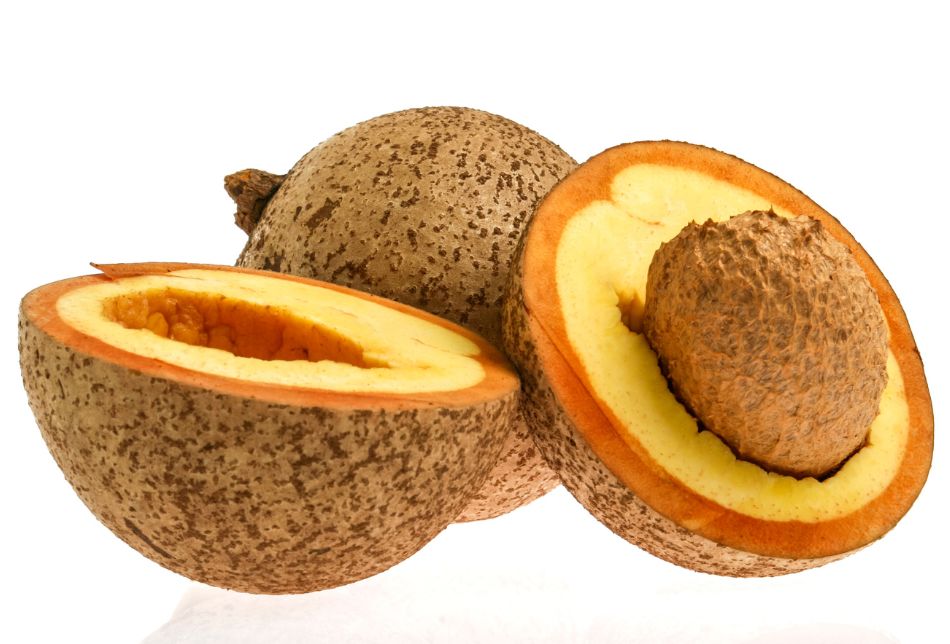
The mamey apple has reddish-brown skin and orange flesh with a sweet, slightly nutty flavor. It is used to prepare desserts like pies and ice cream or made into jams, smoothies, and jellies.
The mamey apple is an excellent source of fiber, Vitamin C, and carotenes.
It also contains antioxidants and other nutrients that have been linked to health benefits like cancer prevention and reduced inflammation.
22. Mamey Sapote
Mamey sapote is a tropical fruit native to Mexico and Central America. It’s sometimes called “red mamey.”
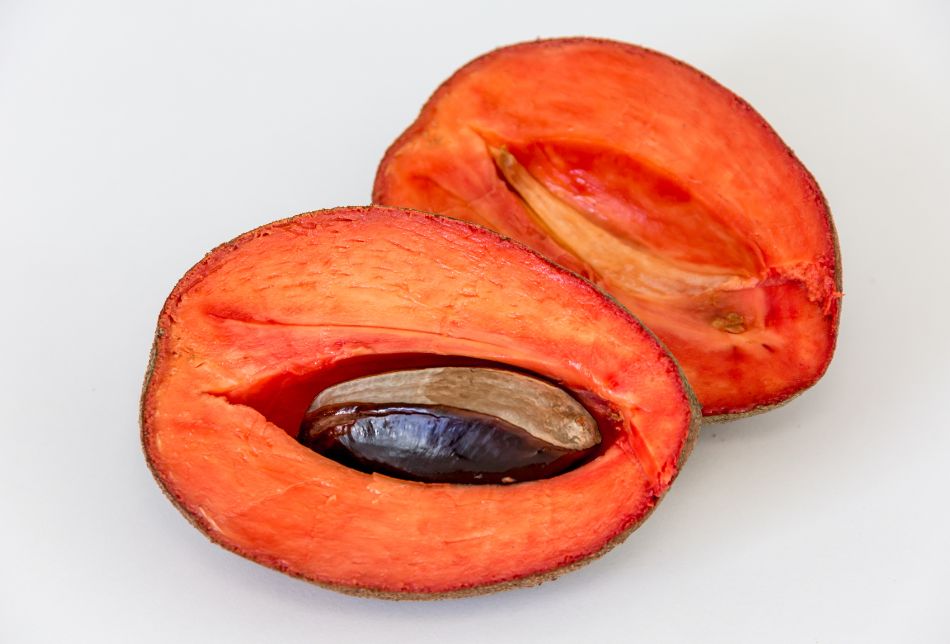
The mamey sapote has thick, brown skin with a soft, fleshy inside similar in texture to a pumpkin or sweet potato. The flesh can be yellow or salmon-colored to even pumpkin orange.
This unique fruit is known for having apricot notes, hints of sweet potato and persimmon, and nuts spices like cinnamon or nutmeg.
Mamey sapote is an excellent source of vitamins C and B6 and potassium and copper. Gulp it fresh or use it in recipes like puddings, muffins, mousse, etc.
23. Mangoes
The next food on our list is mangoes.
Mango trees are a tropical fruit that originated in India around 4000 years ago.

The Mangifera species manufacture them, and they come with all shades of yellow to orange to red on their outside, varying wildly within each color range.
Mangos flesh is deep orange colored due to its rich Vitamin A content, which provides health benefits such as improved vision or anti-aging properties for skin cells.
A fact: There are 500-1000 varieties of mangoes available worldwide.
24. Maprang
Maprang is originally from Southeast Asia. It’s also known as the Gandaria, Plum mangoes, and Marian plums.
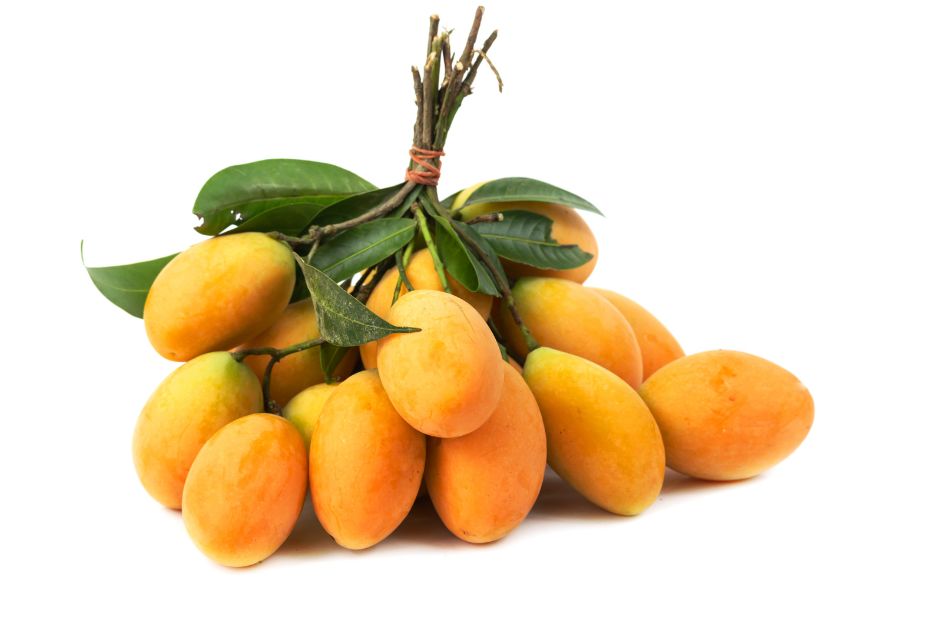
Maprang fruit is thin, light green outer skin with bright orange flesh. They’re also fibrous and juicy, like mangoes, but with the consistency of smooth plums.
Maprang fruits are an excellent source of Vitamin C, carotenes, and other antioxidants.
Maprang fruits are enjoyed fresh or cooked. The spicy condiment sambal is made from chopped-up fruits, while young leaves are also consumed in salads.
25. Marigold
Marigolds are a type of flower native to South America, Tropical America, and Southwestern America. The marigold flower’s petals are used, and they can be eaten fresh, dried, or cooked.
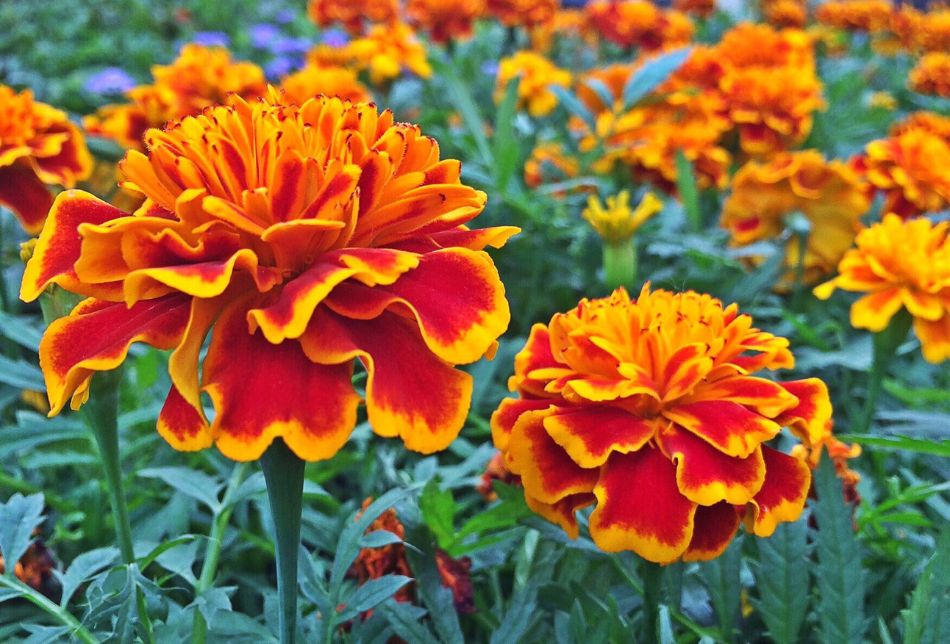
The marigold flower has a taste that combines the flavor of both tarragon and citrus. The color of marigolds ranges from yellow to deep orange.
Marigold petals add a vibrant pop of color to various dishes, such as cakes and soups.
The bright hue is perfect for stews or braises that you might want some extra flair.
26. Nasturtium
Nasturtium is a type of flower that’s related to the watercress plant. The leaves and flowers of nasturtium are edible and have a peppery flavor.

Nasturtium is native to Central America and South America. The leaves are rich in Vitamin C, iron, and minerals.
The flowers provide a good source of vitamin C, B1, B2, and B3 and iron and manganese.
Nasturtium can be used in salads, sandwiches, or as a garnish. The flowers can also be candied or used to make nasturtium syrup.
Pickled nasturtium seeds are also a popular condiment in many parts of the world.
27. Orange Carrots
Orange carrots are the most common type of carrots, but they’re not the only color that carrots come in. Carrots can also be white, yellow, red, or purple.

Orange carrots receive their color from beta-carotene, an antioxidant converted to Vitamin A in the body. Vitamin A is essential for vision, immunity, and cell growth.
Its origins date back to 16th century Holland, which was first hybridized with other varieties.
After that, they began moving around Europe, finally ending up in England during Elizabethan times.
They’re a good source of fiber, vitamins C and K, and potassium. Carrots can be eaten raw or cooked in all sorts of dishes.
28. Orange Bell Peppers
Bell peppers come in various natural colors, including green, red and yellow. Orange bell peppers are one of the sweeter varieties and have a slightly fruity flavor.

They’re native to tropical America. They have an interesting flavor, with sweet and tangy traits.
Orange bell peppers are a colorful and flavorful addition to salads, sandwiches, pizzas, and much more.
Orange bell peppers provide us with vitamins C and A and fiber. They can be eaten raw or cooked.
29. Orange Cauliflower
Like bell peppers and carrots, cauliflower comes in many colors, including white, green, purple, and orange.
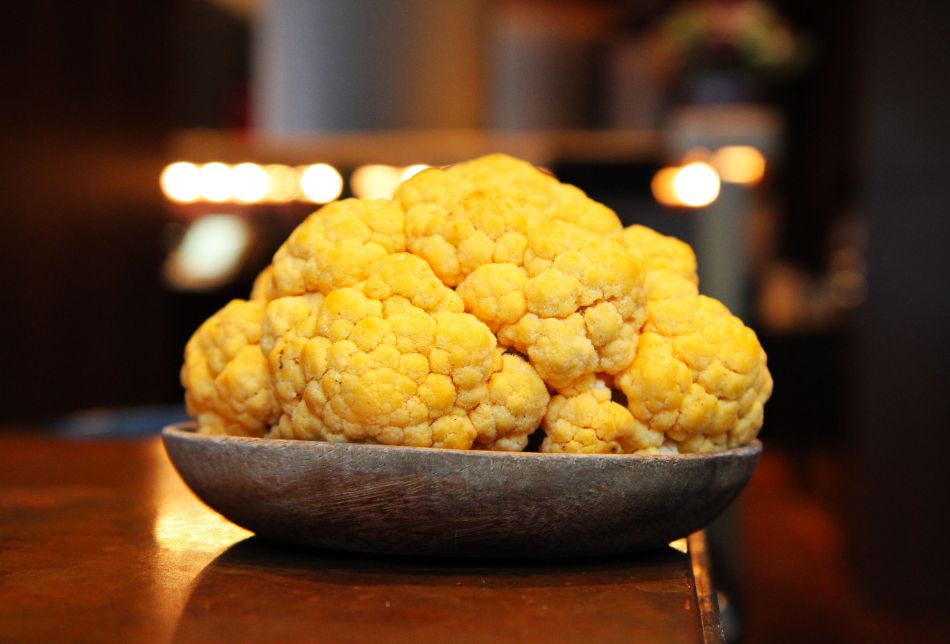
The orange cauliflower gets its color from beta-carotene, an antioxidant converted to Vitamin A in the body. Vitamin A improves skin complexion.
Orange cauliflower is a good source of fiber, vitamins C, potassium, and fiber. It can be eaten uncooked or cooked in all sorts of dishes.
Orange cauliflower was first developed in Canada in the 1970s due to cross-breeding of the naturally mutant cauliflower (having extra beta carotene) with white.
30. Orange Chrysanthemum
Chrysanthemum is also available in nature in many colors, but orange is one of the most popular. The orange chrysanthemum flower symbolizes a “feeling of delicate love.”
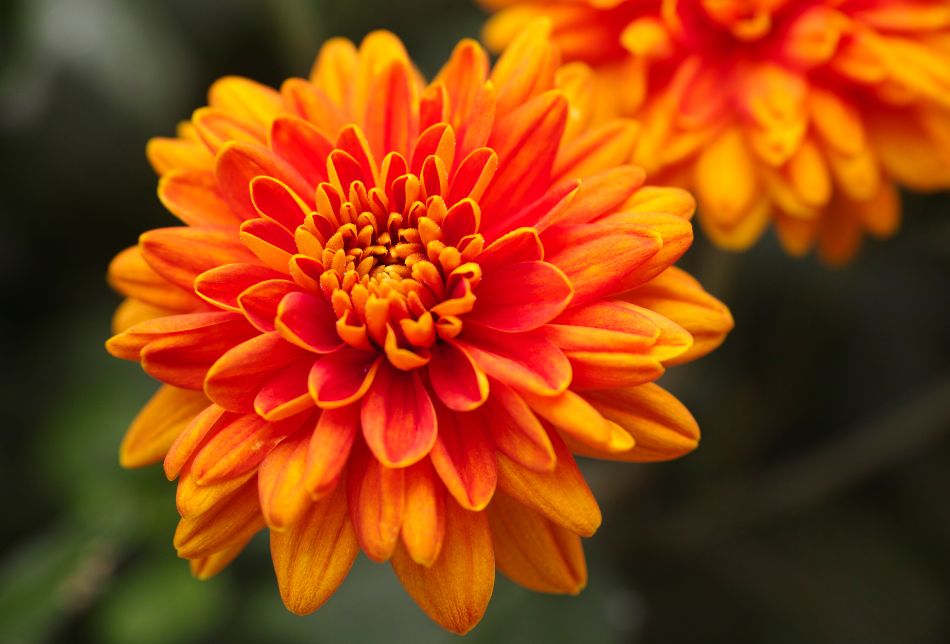
The chrysanthemum has a long history and was first cultivated in China over 2,500 years ago.
The flavor of chrysanthemum is somewhat sweet with a buttery warmth.
You can eat the petals or cook them, or make herbal tea. Chrysanthemum is rich in antioxidants and vitamins A and B, folic acid, choline, and beta carotene.
31. Orange Habanero
Orange habanero peppers are a type of chili pepper that’s very spicy. They’re one of the hottest peppers in the world, and they’re often used in hot sauces or as a powder to add flavor to food.
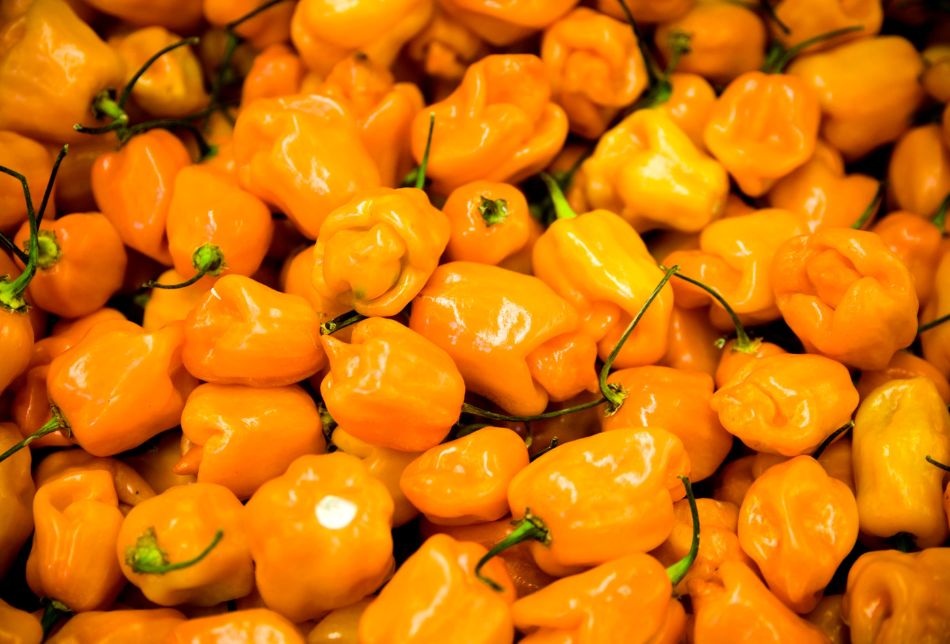
The orange habanero chili pepper is native to the Caribbean and has a fruity flavor with a hint of heat.
These peppers are an excellent source of vitamins C and A, as well as iron and potassium.
Capsaicin has been linked to health benefits like pain relief and reduced inflammation.
32. Orange Raspberries
Raspberries come in many colors, including orange. Orange raspberries are a natural mutation of red raspberries.
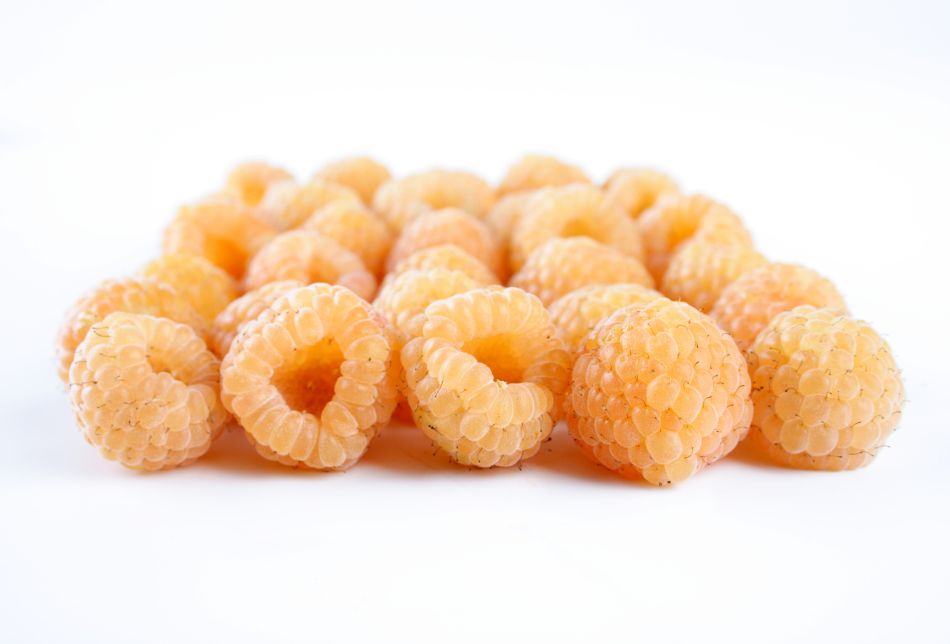
They have a tart-tangy flavor with a sweet finish. Orange raspberries are lower in sugar than other types of raspberries, making them an excellent choice for those watching their sugar intake.
Orange raspberries are an excellent source of Vitamin C, calcium, and iron.
They’re also a good source of fiber. Relish raspberries fresh or add them to all sorts of recipes.
33. Orange Watermelon
Watermelon is a type of fruit that’s popular in the summer. It comes in all shapes and sizes, but they’re usually round or oval with green, white, or yellow stripes on the outside.

The flesh is pink, red, or orange and filled with seeds.
Orange watermelons are a variety of watermelons that have orange flesh. They have been around since ancient times.
Orange watermelons are thought to have originated in Southern Africa.
Watermelons are about 92% water but also contain vitamins A and C and lycopene – and antioxidants that give them their color.
Lycopene has been linked to health benefits like cancer prevention and reduced inflammation.
34. Papaya
Papayas are a fruit native to Mexico, Central America, and northern South America. It has an orange flesh with black seeds.

Papayas have a sweet flavor with hints of mango, banana, and peach. They’re also a good source of vitamins C and K and fiber.
Papayas can be eaten fresh or used in all sorts of recipes, such as smoothies, salads, salsas, and desserts.
35. Peaches
Peaches are a type of stone fruit that’s popular all over the world. They have a fuzzy exterior and a soft, fleshy interior with a large, hard pit in the center.

Peaches come in many colors: yellow, pink, white, and red. They have a sweet taste with a slightly tart acidity.
Peaches are a noted source of vitamins A and C, fiber, and potassium.
The peach is native to China but can now be found in many countries. It’s often eaten fresh or used in desserts like pies and cobblers.
36. Persimmon
The persimmon is a delicious, sweet fruit with an occasionally fibrous texture. It was first cultivated in China over 2000 years ago and introduced to Japan during the 7th century before being distributed all over Asia.
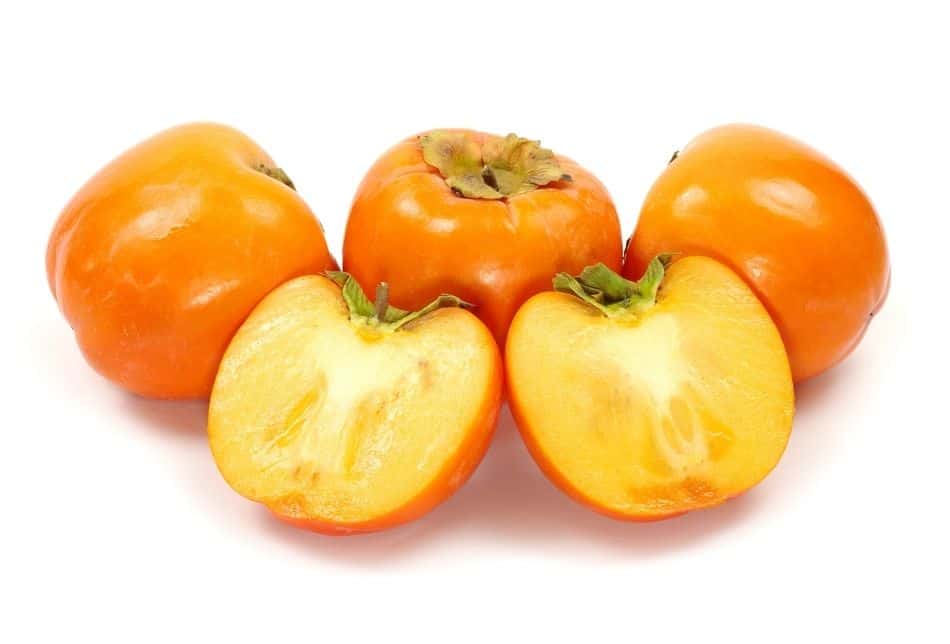
They’re a source of vitamins A and C and fiber. Persimmons can be eaten fresh or used in many recipes, such as drinks, jellies, pies, puddings, and curries.
The word persimmon is a Native American term meaning “a dry fruit.” The origin of this name is the Powhatan language.
37. Pumpkin
Pumpkins are a type of winter squash popular in the United States around Halloween.

Pumpkins come in many shapes and sizes, and their flesh can range in color from orange to yellow.
Pumpkins are an excellent source of Vitamin A, carotenes, potassium, and fiber.
They can be roasted, pureed, or added to all sorts of recipes for a delicious and healthy treat.
Though not as thin or delicate as summer squash, the skin is edible, and you can even eat its seeds.
38. Red Lentils
Red lentils are a pulse-type often used in Indian and Middle Eastern cuisine. They have a red/orange color and are small, disk-shaped, and slightly flat.
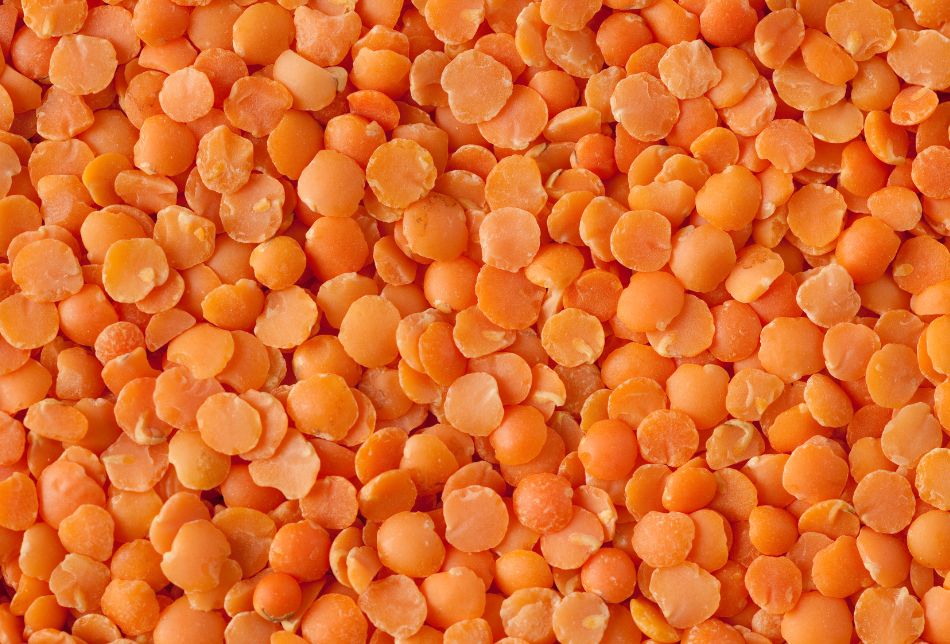
Red lentils are cooked until they’re soft and then mashed or pureed to make dishes like dal or soup. Sprout them, eat them raw, or make them into a delicious vegan burger patty.
Red lentils are a good source of protein, fiber, iron, and several other vitamins and minerals.
They’re also low in calories and fat. Red lentils have a mild, slightly sweet flavor and a soft texture.
A fact: Some soak them before cooking to reduce the cooking time or cook them longer for a creamier texture.
39. Salmon
Salmon has an orangish-red colored fillet with low-fat content. It is native to the tributaries of the pacific ocean and the North Atlantic ocean.
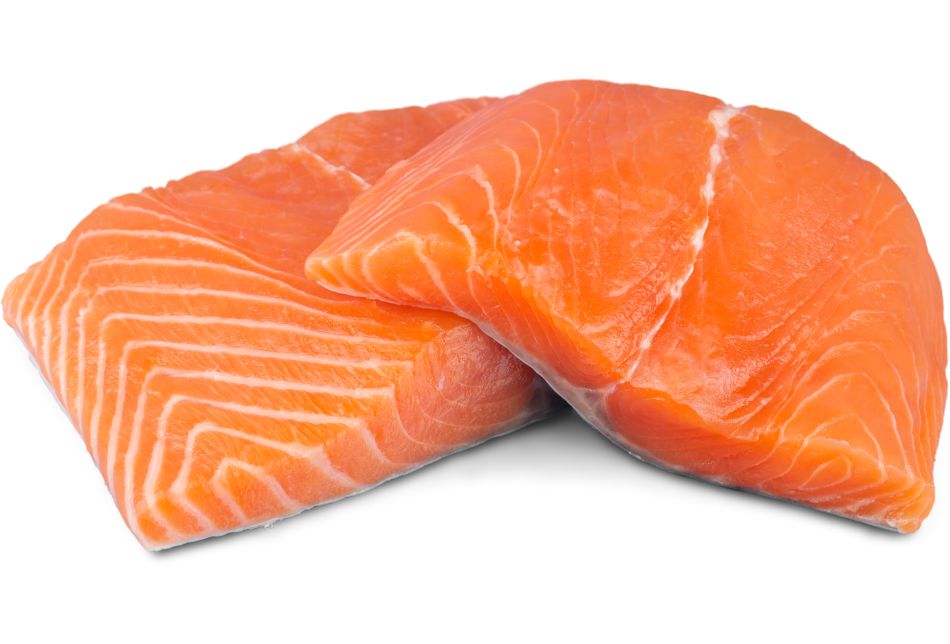
Salmon is an oily fish rich in omega-3 fatty acids, which are beneficial for heart health. It is also a good source of protein, vitamins A and D, and minerals such as selenium and zinc.
Salmon can be cooked in various ways, such as grilling, baking, smoking, or poaching before serving with rice or vegetables.
Fact: There are several different types of salmon found worldwide, including Atlantic salmon, chinook salmon, coho salmon, and sockeye salmon.
40. Salmonberry
Salmonberry is a rubus fruit, including raspberries, blackberries, and dewberries.

It’s a small fruit that resembles a raspberry but is orange or yellow.
Salmonberry has a sweet-tart flavor with hints of citrus and floral notes.
This fruit is native to the west coast of North America, and it’s used in jams, jellies, pies, and syrups. Salmonberry is also a good source of Vitamin C, K, other antioxidants, and manganese.
41. Salmon Roe
Salmon roe is the eggs of a salmon fish. The eggs are typically laid in late autumn, and the salmon swim upstream to lay them in fresh water, where they hatch.
After hatching, the young salmon spend a few years in freshwater before migrating to the ocean.
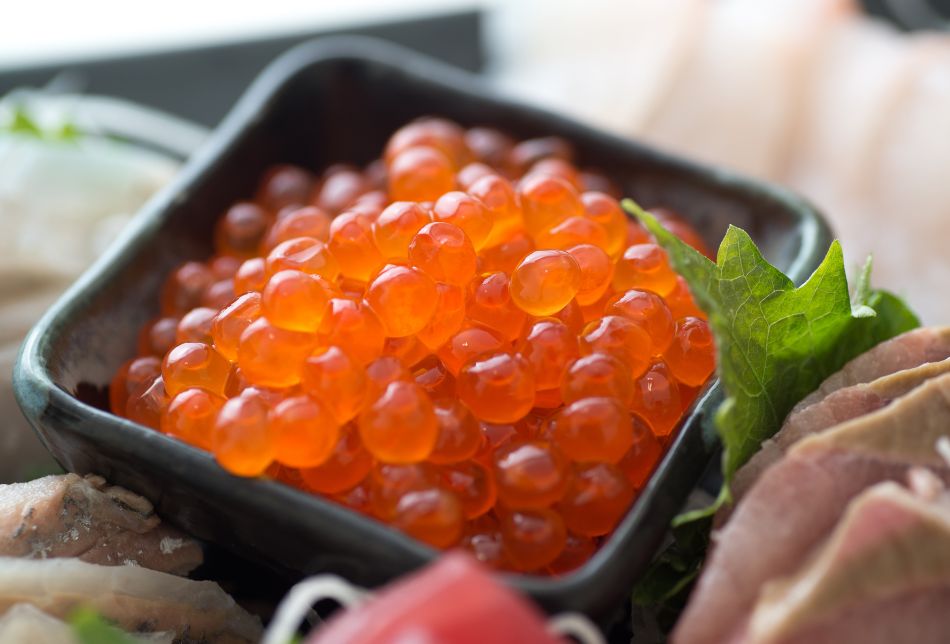
Salmon roe is orange or red and has a slightly salty taste with a firm texture.
Salmon roe is often used as a garnish or to add flavor to dishes.
It’s a good source of protein, omega-3 fatty acids, vitamins, and minerals. Salmon roe can be eaten raw, cooked, or pickled.
42. Scarlet Runner Bean Flowers
The scarlet runner bean is a leguminous herbaceous plant native to tropical America. The beans are used in many dishes, but the flowers are also edible.
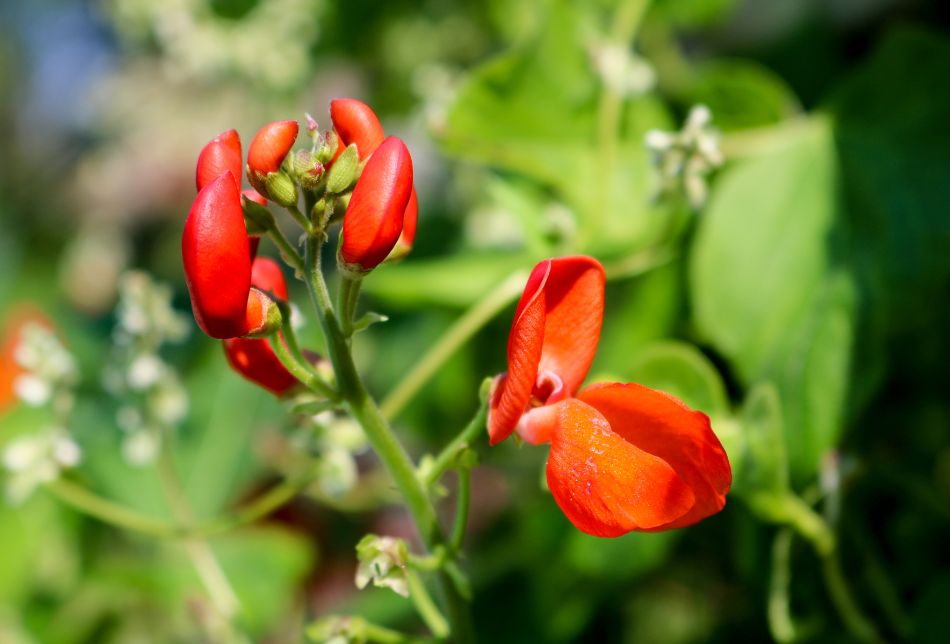
Scarlet runner bean flowers have a bean-like flavor. They can be eaten raw or cooked, making a beautiful addition to salads or other dishes.
Scarlet runner beans are a good source of fiber, protein, vitamins C and K, iron, and magnesium.
They can be prepared in several ways and used as a replacement for meat in vegetarian dishes.
43. Sweet Potatoes (Jewel Sweet Potatoes)
Sweet potatoes are tubers that come in many colors, shapes, and sizes. The most common type of sweet potato is the orange-fleshed variety with brown skin, which can also be white, yellow, red, or purple.
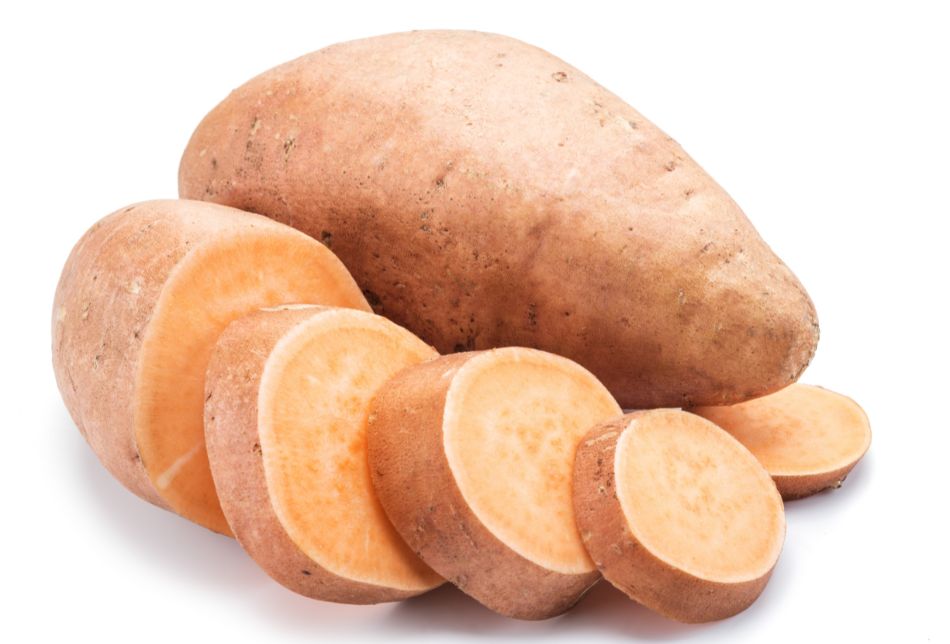
Sweet potatoes are a powerhouse of Vitamin A (in the form of beta-carotene), Vitamin C, manganese, and potassium. They’re also a good source of fiber and other vitamins and minerals.
Sweet potatoes are native to Central and South America but are now produced the world over.
They were first brought to Europe by Spanish explorers in the 16th century.
Sweet potatoes can be roasted, fried, baked, or cooked in different delicacies.
44. Squash Blossoms
Squash blossoms are the edible flowers of squash plants and can be found in various varieties. It is native to the Middle East.
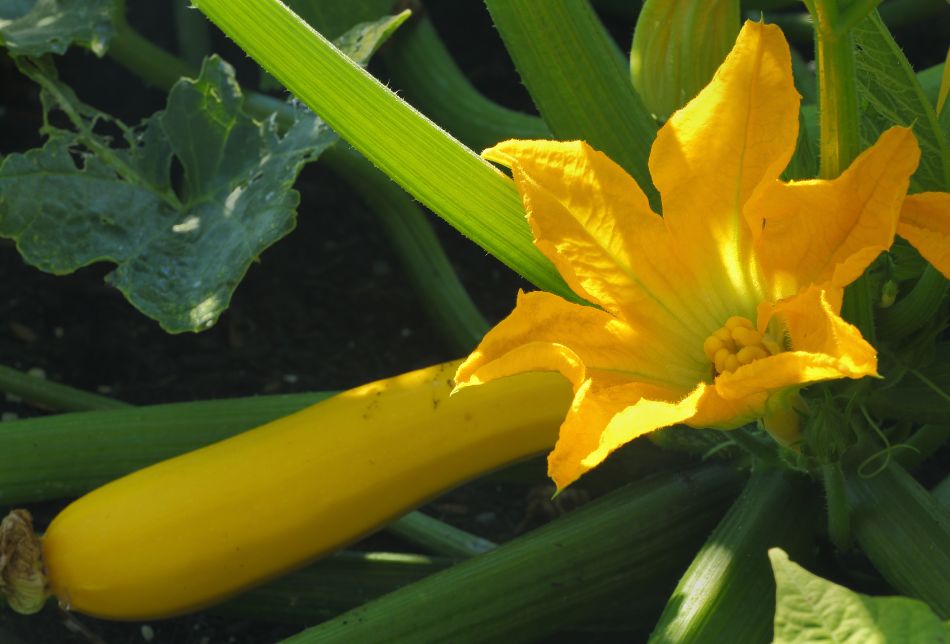
Squash blossoms have a delicate, slightly sweet flavor with hints of grassiness. They’re used in salads or as a garnish for soup or pasta dishes.
Squash blossoms are an excellent source of carotenes, vitamins, minerals, and antioxidants.
They’re also low in calories and are fat-free, making them a healthy addition to any diet.
45. Tamarillo
Tamarillo is a type of tomato and it’s native to South America.
It’s also known as the tree tomato, tomate de arbol, chlto, blood fruit, tamamoro, tomate de yuca in South America, and terong belanda in Indonesia.
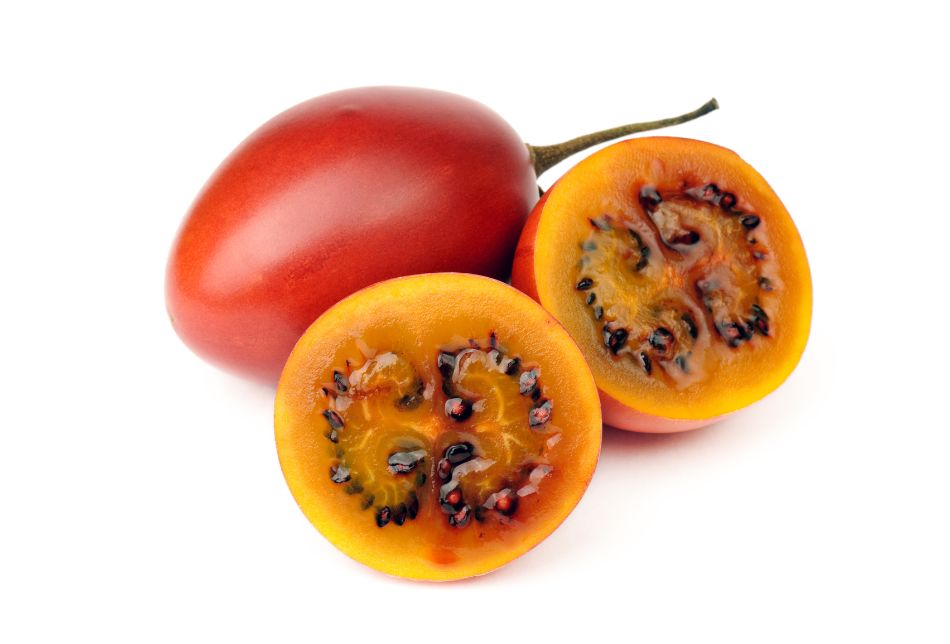
The tamarillo fruit is oblong-shaped with smooth, tough skin that can range in color from deep yellow to orange-red.
The flesh of the tamarillo is orange and contains large seeds.
This fruit has a tart, acidic flavor with hints of sweetness.
Tamarillos are an excellent source of vitamins C, E, A, carotenes, and other antioxidants. Tree tomatoes make delectable jams, jellies, sauces, and other dishes.
46. Turmeric
Turmeric is a yellow-orange spice used in Indian and Asian cuisine. It has a slightly bitter taste and a strong, earthy aroma.

Turmeric is made from the Curcuma longa plant’s dried ground root. This plant is native to South Asia, and it has been used medicinally for centuries.
Turmeric contains curcuminoids, which are powerful antioxidants with anti-inflammatory and anticancer properties.
It’s also a good source of vitamin C, B6, potassium, iron, and manganese.
You can use it to make curries, soups, stews, and other dishes. You can also add it to smoothies or take it in supplement form.
47. Ugli Fruit
The ugli fruit is a type of citrus fruit native to Jamaica in the Caribbean Islands. It has a teardrop shape with thick and rough skin.
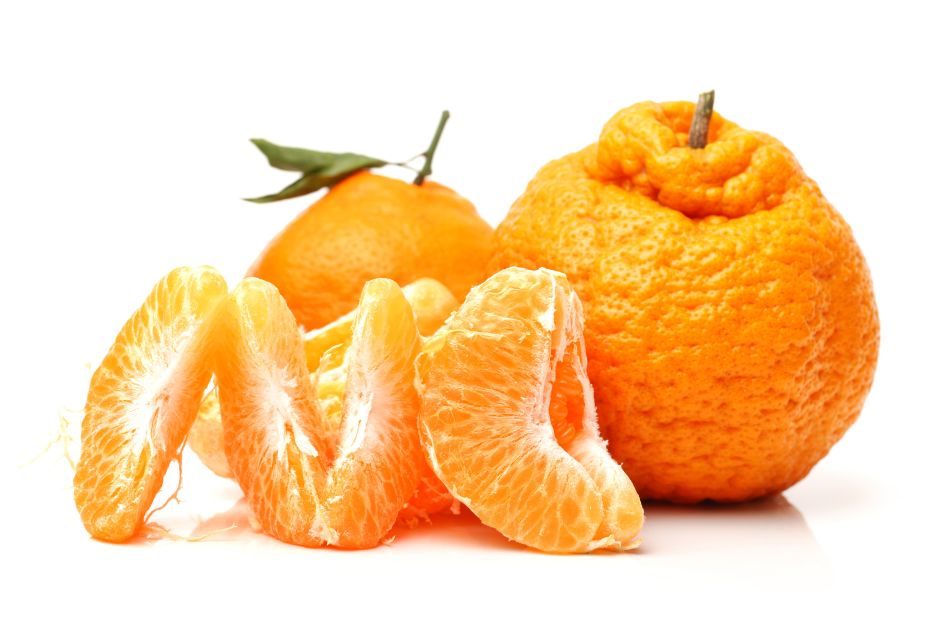
The ugli fruit is orange on the inside with a juicy, slightly acidic flesh. It is an excellent vitamin C source and contains smaller amounts of Vitamins A and C.
Ugli fruits are often used in salads, jams, jellies, and other desserts. They can also be eaten fresh or juiced.
48. Uni
Uni in Japanese means sea urchin, which refers to the edible orange roe found inside the shell.
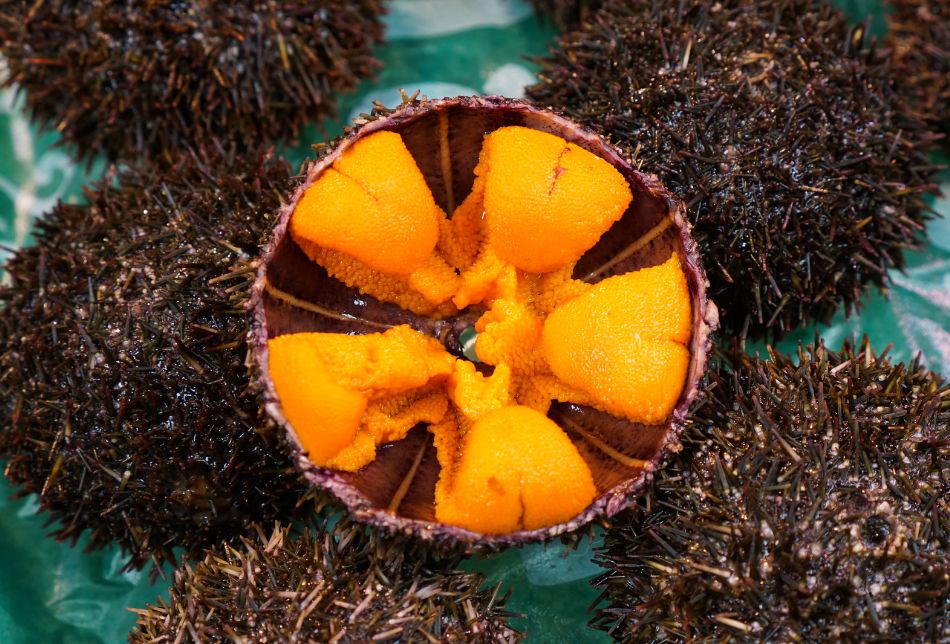
Uni is a sushi type that is often served as nigiri (sushi where the fish is draped over a ball of rice).
Uni has a creamy texture and a slightly sweet and briny flavor. It’s an excellent source of protein, healthy fats, and vitamins A and C.
Also called corals or gonads, uni urchins are healthy. One hundred gm of uni urchin contains only 172 calories.
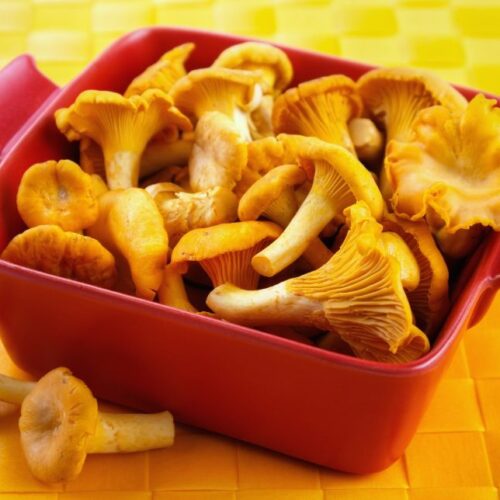
Foods That Are Orange In Color
Ingredients
- Annatto
- Apricot
- Butternut Squash
- Calendula
- Cantaloupe
- Cape Gooseberry
- Chanterelle Mushrooms
- Cheddar Cheese
- Cherry Tomatoes
- Clementines
- Crab Roe
- Curry Powder
- Dalandan
- Duck Sauce
- Dutch Mimolette
- Gấc (Sweet Gourd)
- Grapefruit
- Horned Melon (Kiwano)
- Kabocha Squash
- Kumquats
- Mamey Apple
- Mamey Sapote
- Mangoes
- Maprang
- Marigold
- Nasturtium
- Orange Carrots
- Orange Bell Peppers
- Orange Cauliflower
- Orange Chrysanthemum
- Orange Habanero
- Orange Raspberries
- Orange Watermelon
- Papaya
- Peaches
- Persimmon
- Pumpkin
- Red Lentils
- Salmon
- Salmonberry
- Salmon Roe
- Scarlet Runner Bean Flowers
- Sweet Potatoes (Jewel Sweet Potatoes)
- Squash Blossoms
- Tamarillo
- Turmeric
- Ugli Fruit
- Uni

